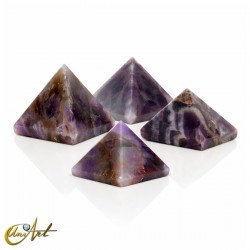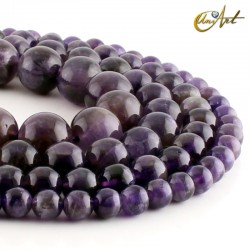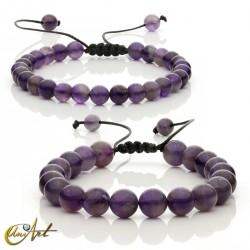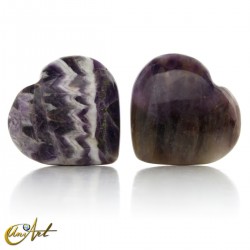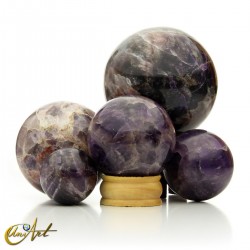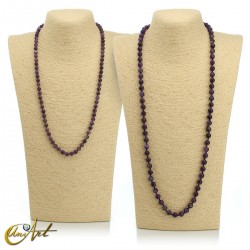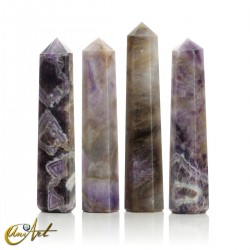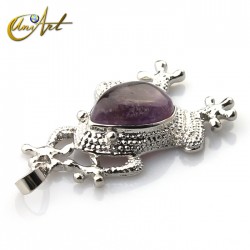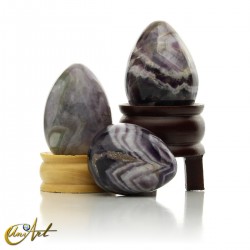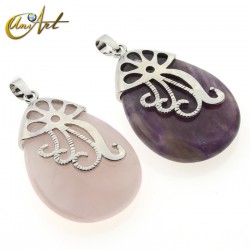Amethyst
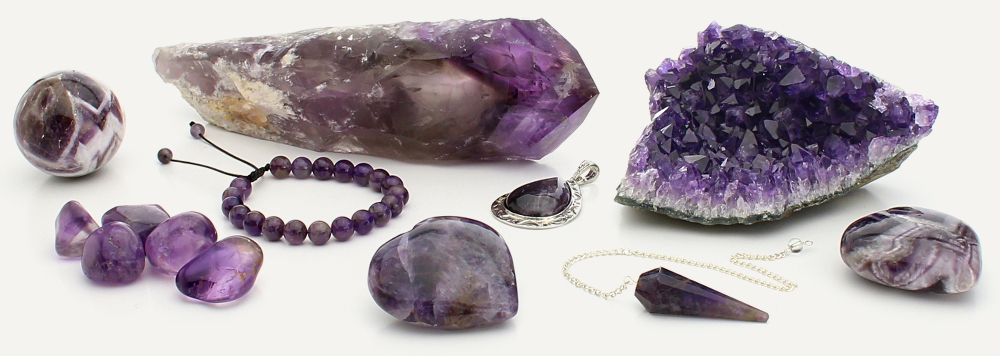
All about amethyst: Information, uses, properties and products of this semi-precious stone.
We've got plenty of amethyst information for you. Explore all the topics we have compiled and get to know this natural stone better.
History, etymology and meaning
History of Amethyst as a semi-precious stone
Amethyst is the name given to purple quartz. It was considered a precious stone and as valued as diamonds until the 18th century.
There were many ancient civilizations that appreciated its beauty, amethyst was already known in prehistoric times by the Greeks, Romans and Egyptians. Due to its beauty and color it became a symbol of wealth and power.
In the Middle Ages it was widely used to make talismans and magic spells as it was considered an amulet to preserve chastity and sobriety.
In the Catholic religion, amethyst was adopted as the Bishop's stone and even today some bishops wear a ring with this gem.
When important natural deposits of amethysts were discovered in Brazil, this semi-precious stone became more affordable, making it possible to buy amethyst at much more attractive prices. Even so, amethyst quartz has not ceased to be one of the most coveted minerals in the world of jewelry and to this day this wonder of nature is used to make jewelry and other products with amethyst stones.
Etymology of the name amethyst.
The word amethyst has its origins in the Greek Amethystos which means not drunk.
The ancient Greeks and Romans used it as an antidote against drunkenness.
Probably this belief has its foundations in Greek mythology and in the cult of Dionysus, god of wine.
Pursued by Dionysus, who desired her, a chaste nymph named Amethyst cried out for her help to the goddess Artemis who, to protect her from her, turned her into a pure and colorless crystal. The god, seeing what she had caused, had remorse and as a sign of sadness he spilled the contents of her cup on the glass, which turned purple, acquiring the color of wine.
That is why in ancient times protective properties against the effects of wine were attributed to amethyst.
Meaning of amethyst
Among all the minerals, surely the one with the most mystical significance is amethyst quartz.
Its purple color is the color of spirituality and therefore this stone is related to the seventh ray of the rainbow, which gives this quartz a deep esoteric meaning.
The new spiritual movements, the so-called “New Age” movements, attribute to amethyst surprising energetic properties and great importance, being one of the energetic minerals most used in esotericism. It is considered the stone of transmutation.
In astrology, amethyst is the stone of the sign of Pisces and as a birthstone it is associated with the month of February.
In addition, we cannot forget the great mystical relevance of this semi-precious stone in Catholicism and in ancient prehistoric cultures.
Properties and therapeutic uses
Energetic properties of amethyst stones
When we talk about the energy properties of minerals, especially amethyst, we have to do so within a metaphysical framework.
Modern science does not support the claim that certain energetic and non-empirical properties reside in minerals and give them powers and characteristics beyond materialistic perception.
However, there are many energy properties attributed to amethyst and most of them are related to its use in ancient times.
As we have previously mentioned, there are many powers attributed to this stone, considered magical and until today it is used as a receptacle of energy at any level with the ability to transmute these energies, transforming negative charges into positive and beneficial charges for humans. living beings.
Since amethyst is a highly sought after mineral today for its energetic properties, it is encouraging to imagine that all the beliefs revolving around this enchanted stone are true.
Within these principles that transcend the conventional we find the use of geodes and amethyst druses to harmonize the environment. According to Feng Shui and also other techniques that use the energetic properties of amethyst at a paranormal level, it is advisable to decorate certain areas of the house with an amethyst geode or a druzy of considerable size.
Regarding the concept of the Chakras, supposed vital energy centers of the body, amethyst quartz is linked to the sixth and seventh Chakras.
As these are the Chakras responsible for intuitive vision and connection with the spiritual universe, we can say that amethyst is the stone of psychic force, capable of sharpening the mind, intuition and strengthening spiritual gifts. It is also a powerful ally for concentration and meditation.
The use of the properties of amethyst to benefit the Chakras is done with the use of flat carved stones or rounded edges that are positioned on the Chakra to be treated. Also, for this purpose, the use of jewelry or costume jewelery made of this natural stone is allowed. Apparently using an amethyst bracelet, pendant or earring made of this mineral would already be enough to achieve the benefits provided by this semiprecious stone.
Rough amethyst is also indicated for the benefit of the Chakras. A geode in the room or a druzy on the study table would be ideal for these purposes.
Beliefs about the therapeutic use of amethyst quartz
Although there is no scientific evidence, there is a belief that amethyst stones have a lot of power and are protective minerals, so those who use them for therapy defend that this mineral can be used to calm, help unblock energy, increase memory capacity, relieve physical, emotional and psychological stress by reducing stress caused by different factors and strengthening the mind.
The truth is that amethyst quartz has been used by ancient cultures for these purposes. The ancient Greeks and Romans already believed in its power to keep the mind healthy and protected from intoxication. In the art of goldsmithing in ancient Egypt, amethyst had a medicinal and religious character, there was a belief that amethyst jewelry was imbued with magical and healing properties.
Physical characteristics and quality criterion
Characteristics and properties of the amethyst stone
It is a mineral that belongs to the macrocrystalline quartz family group, which is why it is often called amethyst quartz. On the Mohs scale it presents hardness 7.
Of magmatic origin, this semi-precious violet stone can occur in nature as a druse inside geodes, in the form of massive or present in veins.
The color that characterizes this mineral is due to the presence of iron in its composition. Depending on the amount of this impurity we will observe from a pastel lilac tonality to intense purple violet, this tone being the most valued and coveted.
Sensitive to heat, amethyst becomes citrine when heated to high temperatures.
Brazil, Uruguay, South Africa and Madagascar are the world's largest producers of this stone.
In the south of Brazil and Uruguay, the extraction of drusen and geodes predominates, the forms most in demand. But the amethysts from Uruguay are the most beautiful in the world for their intense color and vitreous luster.
Amethyst mineral qualities
The qualities of amethyst are relative to its color purity and transparency.
The more intense, vibrant and deep the color, the more commercial value the stone will have.
Apart from the color, transparency also gives the amethyst stone a better quality, in addition to other aspects such as the absence of inclusions, cracks or impurities.
A quality gem has to be clean, deep in color, totally transparent and of optimal brilliance.
As an exception we have some varieties of the amethyst mineral that are highly valued but do not follow these rules.
The rose de france amethyst is a spectacular variety of superior quality amethyst that has a light pinkish lilac color and therefore achieves great prestige in the semiprecious stone market.
Amethyst gemstones with rutile (gold-colored inclusions) are highly prized in fine jewelry and by collectors. In this case, the more rutile inclusions, the more valuable the gem is.
How to clean and preserve the amethyst stone
A natural stone like amethyst is usually very resistant and has great durability if we know how to take care of it.
In general, a natural mineral can be passed from generation to generation with hardly any changes and some small care can contribute so that its beauty lasts for a lifetime.
How to clean amethyst?
We can understand physical cleaning as the process of removing dirt and dust from a piece of amethyst and energetic cleaning as the mystical ritual that is performed to purify the mineral from harmful energies.
Physical cleanliness:
If we have a piece in the rough, we should see if the base is natural basalt or if it is painted mortar.
Normally the drusen from Uruguay have a natural basalt matrix while the geodes from Brazil are covered by mortar.
Both one and the other can be washed in soft running water, taking care to hold the piece very well to avoid bumps. It is important to know that hard water can diminish the brilliance of the amethyst crystals and for this reason it is always advisable to wash them in water with weak mineralization.
In the case that it is a geode covered with mortar, it is recommended to avoid prolonged contact with water and never leave it submerged since the water can soften the mortar and the geode can break.
The amethyst should be allowed to dry naturally with the crystals facing down to make it easier for water to drain off.
Since they are carved pieces of amethyst, the cleaning process can be carried out with a microfiber cloth soaked in water or mineral oil. Children's body oils usually give good results.
The oil not only cleans but also enhances the shine and seals the porosity of the stone, protecting the polish.
In all cases we must not use chemical products or abrasive materials.
Energy cleansing of amethyst :
When the amethyst is used for esoteric purposes, its wearer may need to energetically cleanse it.
Energy cleaning is a ritual, which must be performed by the person who uses the stone.
The best-known rituals are the bath with salt water, the sun and moon bath, and the use of incense.
Salt should be avoided when cleaning stones set in metal, since the setting can oxidize.
The rest of the pieces can be submerged in a solution of water and salt or in seawater, but afterward it must be rinsed very well with soft water to avoid deposition of salt on the crystals.
The moon and sun bath is carried out leaving the piece exposed to the light of the full moon and later to the light of the sun.
In this procedure, it must be taken into account that amethyst crystals lose their color when exposed to ultraviolet rays for a long time. So if we use this ritual many times and for many hours the purple of our amethyst will lose its intensity.
The incense is a simple procedure and consists of leaving the stone exposed to the smoke of the incense while it burns.
It is advisable to leave the instance well ventilated whenever incense is burned and to avoid breathing the smoke directly.
After the energetic cleansing, it is always recommended to perform the physical cleansing.
How to preserve amethyst stones?
The ideal for a decorative piece of amethyst is that it be kept sheltered from light and protected from dust and pollution.
An amethyst exposed to direct light year after year loses color intensity and fades.
Jewelry made with amethyst should be stored in such a way that it does not come into contact with other objects that could scratch the gem.
Other stones with greater hardness can damage the surface and polish of the gems.
In general, amethyst is a stone that is very easy to preserve and highly durable.
Amethyst Products
Buying amethyst online is easy at the UniArt store.
Amethyst geodes and druses: find the most beautiful pieces raw to buy.
In our category of rough amethysts you will find everything from Uruguayan druses to pieces of super seven from Brazil.
Sterling silver jewelry with amethyst

Discover our collections of silver jewelry with natural stones
We have rings, bracelets, pendants, earrings made with amethyst and sterling silver, as well as jewelry with other beautiful semiprecious stones.
Find the amethyst you are looking for among the hundreds of products we have for sale such as pendulums, Tibetan malas, necklaces, pendants, etc...



